

![]()
March 2014
- Munich Tube Amp Magic
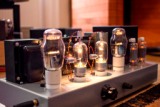
This article was only possible because of the connecting powers of the internet. And it was completely done without the help of Facebook or other nowadays so hip social media platforms. ;-) My website and good old email made it possible that I have become friends with Christoph, a German audio enthusiast and DIY tube amp designer.
So, in a nutshell, here is
how it happened:
I had some Electra Print output transformers for
sale on my website. He had visited my website every now and then, saw
the sales offer, contacted me and bought the trannies. The nice thing
was that we stayed in contact afterwards and had great conversations
via email mostly about our audio hobby, cool tube gear and music.
Finally, about 1 1/2 years ago, he visited me for an audio weekend to
have a listen to my Haigner Gamma horn speakers. Of course, he
brought some of his tube amps with him, including superb-sounding
300B SE mono block amps with the famous German C3m post tubes as
driver. The weekend was a blast!
Both days of his
visit, we listened until the morning hours to our beloved music,
chatted about the advantages of tube amps, our love for SE tube amp
designs and horn loudspeakers in particular and enjoyed some good
glasses of wine and nice food. Christoph’s knowledge of audio tubes
and amp designs is admirable. I got the feeling he knows mainly all
tube types as well as their pros and cons in relation to their usage
for audio purposes. He also has a very minimalistic approach in tube
amp design, which normally results in smaller and lighter amps than I
was used to. Quite a nice touch, as I had to undergo a hernia surgery
two years ago. :-)
***
You all know that I’m a fan of Thomas Mayer’s amp designs and a proud owner of a Mayer 801A SE stereo amp with separate power supply. Due to the large amount of iron Thomas uses in his amp designs, this 801A amp weighs in at a hefty 50 kilograms; however, it is split in two chassis, which makes things easier. Christoph’s EL12 mono blocs, which I had the pleasure to audition, weigh approximately 10 kilos each, quite a remarkable difference, and weight-wise a wonderful treat after my surgery ;-). Thomas’ approach involves a lot of iron, to get current as clean as possible from his extraordinary power supplies using a tube rectifier bridge of 4 TV-damper diodes. In contrast, Christoph normally uses a single tube rectifier (different NOS types like 5V4G/GZ32 but mainly no tv-damper diodes) and a rather simple choke input filter (or capacitor input filter, depending on what he thinks is appropriate for the project) for his SE amp designs. In this way, he achieves low-impedance power supplies. For some of his tube amp projects (for example, the EL12 monos) he went even further and - I can hear some hardcore tube fans scream - tossed the tube rectifier and went the sand amp way by using an RC-filtered ps with shottky diodes and bridge rectifiers instead.
Christoph favors
quality parts in his designs and is a fan of eliminating parts
whenever possible to keep the designs straight and simple. In his
latest designs, for example the EL 12 SE mono bloc amps, he went one
step further and used fixed bias for the output stages instead
of conventional cathode bias, as, regarding parts, he believes in the
principle “less is more.” Lower
impedance in the amp is a big plus, too. Christoph is also a fan of high quality tube sockets and passive
parts as his designs are extremely minimalistic in parts count. He
compares the selection process of audio parts (resistors, capacitors,
inductors and wire) with the art of fine cooking: the choice,
knowledge and mixture of the ingredients will have great influence on
the result, be it a fantastic meal or a great sounding audio design. :-)
Of course, the skills of the cook / audio designer and the quality of
the recipe / layout are very important as well.
As Christoph is someone who appreciates an excellent cook (not to mention creative and tasty meals) and who is a good cook himself, to me his philosophy of audio parts selection made a lot of sense. How cool that I sometimes have the pleasure of trying one of his amp creations in my system. And these amps sound really superb! In particular, I love his flea powered 71 SE amp, an amp with below 1 watt output power, which excels with vocal performances as well as the more powerful EL12 monos, delivering around 4W in SE triode mode. The latter have speed, impact and clean undistorted sound. In addition, his 5W 300B SE monos around the Emission Lab Mesh 300Bs and the C3m as driver tube are fantastic performers. After Christoph had bought David Haigner’s ETF horn loudspeakers about 14 months ago, he also started to design a more powerful SE amp around the famous Russian GM70 transmitting triode with tungsten filament.
Some of Christoph's amps:
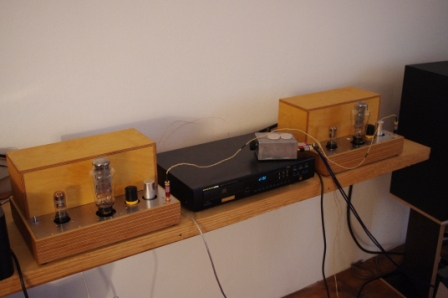 300B EML Mesh Monos with Gessner CD Player
|
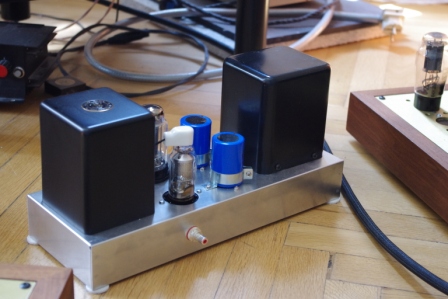 EL12 Monos with RC filtered ps, EF6 driver, cathode biased, used in triode mode |
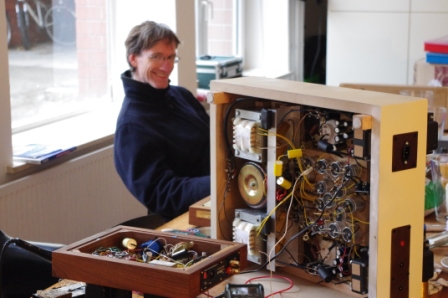
Smiling David plus Moondogs 2A3 rework (left) and GM70 amp in the works
Christoph has invested a large amount of time over the years comparing different parts in his designs with the aim of finding the perfectly-fitting one for the job, of course, according to his subjective taste: for example, the right coupling capacitor connecting driver and output tube stages of his SE amp designs or the best sounding resistors for the grid or plate load.
Since Christoph
bought David Haigner’s ETF-horn loudspeakers, he says that the part
selection has been a breeze as every change in parts can be easily
heard, for better or worse. By the way, the cross-over network of
the ETF-horns were top notch updated and upgraded with superb parts
by David Haigner last year (for example with Duelund capacitors in
the critical treble section and high grade resistors and caps for the
rest of the cross-over). After auditioning this speaker in May as
well as October 2013 in Munich, I can wholeheartedly say that
Christoph’s huge music room is currently the best sounding place I
know for audio reproduction.
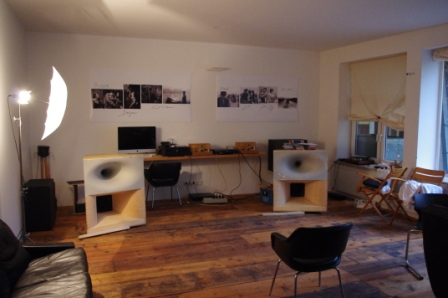
Christoph's wonderful studio with Haigner ETF horns
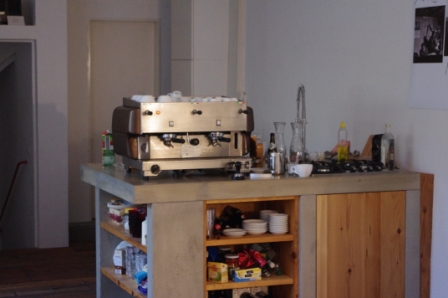
... and the coffee is excellent, too :-)
***
In October, my friend Alexander and I had the pleasure of listening to Christoph’s new GM70 SE stereo amp via Gerald Gessner’s extensively modified CD player based on a Marantz CD-63 chassis and drive. This CD player has - due to Christoph’s request to Gerald - a special 4V output stage to get rid of an additional preamp and only use the GM70 SE stereo amp with built-in volume control. Driver tube in this SE amp is currently the C3m pentode. This setup sounded awesome in October with all kinds of music… from small-scale classical music to full orchestral Mahler symphonies as well as intimate jazz, raw blues, vocal interpretation or hard rock bands.
I’ve never seen my friend Alexander enjoying music that much. :-) He normally prefers Class A sand amps with his Gamma Horn system, because he loves to listen loud and enjoys tight bass performance, but as the GM70 delivered that in spades and added drama and tonal color and 3D holographic sound wherever this was stored on the recording, he was blown away. I was too, by the way. ;-)
Christoph’s music
room (with its 70 sqm dimension in rectangular space, high ceiling
and old wooden floor) is a fantastic environment for a pair of first
class Haigner horn loudspeakers and superb, powerful SE triode tube
amps such as the GM70. Our listening session lasted till the morning
hours that weekend and was pure joy. When we finally played Jeff Beck
performing live “Brush with the Blues” with life-like levels
(from his 1999 CD Who Else!)
it was unbelievable. We all just had to play air guitar and jump
around like young guys enjoying every bit of these earthy blues. ;-)
It’s hard to believe that music reproduction in a home environment
can sound better than this. Simply fantastic and highly enjoyable. :-)
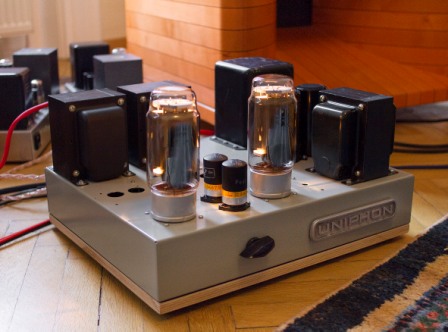
This is the impressive SE stereo GM70 amp with C3m driver - here in my music room - which made us dance :-)
Long live music and NOS
tubes!
Musically yours,
Norbert
Update February 2014:
This February, Christoph visited us here in Vienna for some days and brought three of his latest amp creations with him. These were:
6B4G SE mono bloc amps, with fixed battery bias for the 6B4G, input / driver 12SJ7 in pentode mode with stabilized G2 voltage, power supply with multiple RC filters, solid state rectified and specially selected coupling cap between driver and output stage
a full DHT thoriated tungsten SE stereo amp, 801a fixed bias, 3c24 input / driver with anode choke, ps with 2x EY500 double rectifying and capacitor input. External filament heating for 801a and 3c24 symmetrically RC filtered.
and finally his fantastic UNIPHON SE GM70 fixed bias triode stereo amp with C3m input / driver as pentode stabilized G2 voltage, ps with specially tuned choke input, SS rectifiers, coupling caps copper/polypropylen, external filament heating for gm70, symmetrically RC filtered (see photo above in my room).
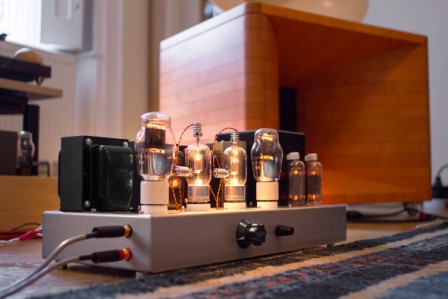
Awesome SE 801A fixed bias stereo amp with 3c24 input / driver
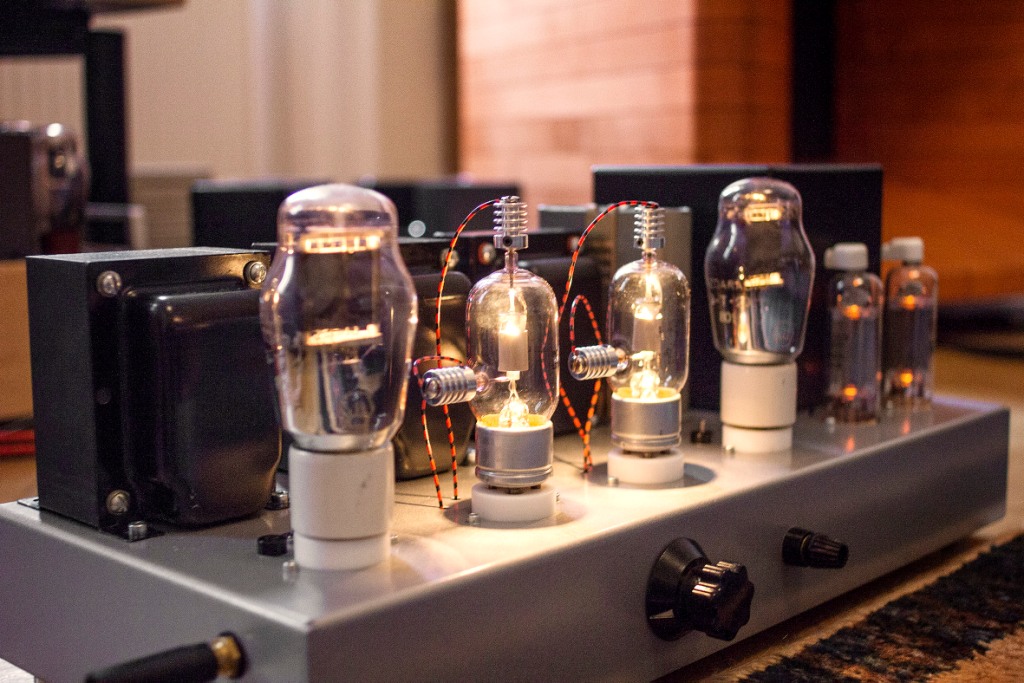
That's an eye-catcher, isn't it? Glorious tungsten filament triodes :-)
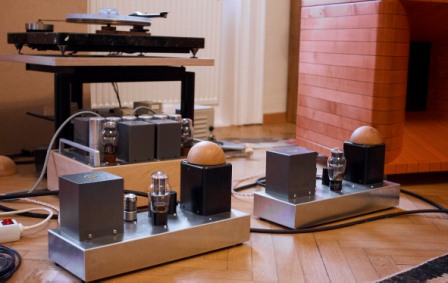
Fixed bias 6B4G SE mono bloc amps, RC filtered ps, 12SJ7 driver tube
We had a blast with some friends at
different venues those days. A lot of great music was played, the
mood, food and drinks were excellent, the talks entertaining and so
the music sessions lasted till the morning hours, every time. :-)
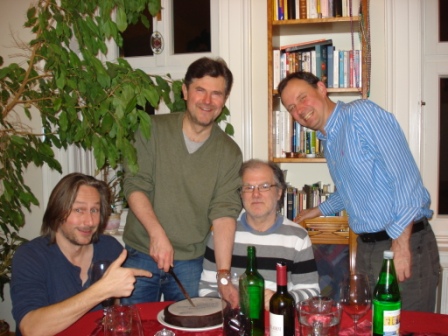
We also had fun besides the listening, as one can see!
All three of Christoph's amps sounded amazing with my Haigner Gamma
horns via Christoph’s 4V output Gessner CD player as well as my
vinyl setup. The DHT thoriated Tungsten amp had amazing details and
speed, the GM70 a huge soundstage and all the shadings you can wish
for in the bass registers – I’ve never heard bass so tuneful –
and the 6B4G monos were fast with wonderful tonal colors. Just superb
amps!
Great to have such a friend :-)
©The
Audio Eagle 2005-2014 •
All Rights Reserved • Disclaimer









